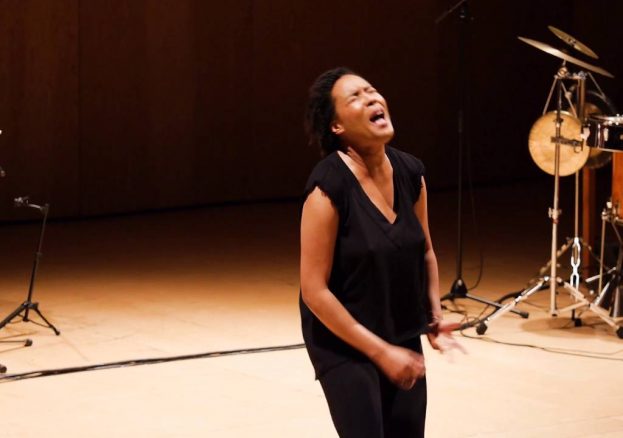
The premiere is commissioned by Bluecoat, Liverpool’s centre for the contemporary arts, where the performance will take place, in partnership with the Stuart Hall Foundation, London, and the International Slavery Museum.
This ambitious 50-minute cross-disciplinary music theatre piece uses text, improvisation and movement, to stage a dramatic engagement with the brutal realities of slavery as revealed by the historical records of the sugar industry, and to reveal its contemporary echoes.
SWEET TOOTH marks the culmination of five years’ research by Mitchener into our love of sugar and the historical links between the UK sugar industry and the Transatlantic Slave Trade.
During this period, she worked with University of Southampton historian Christer Petley, Senior Lecturer in History University of Southampton and an expert in the history of slavery in the Caribbean, and also researched in the archives of Harewood House in Leeds, which was built by 18th century plantation owner Edwin Lascelles.
Some of that material, such as inventories (discovered in Jamaica by Petley) of more than 2,000 enslaved Africans owned by Samuel Taylor, another 18th century British sugar baron, provides the basis for the dramaturgy of SWEET TOOTH.
Running in parallel with this historical research, an intensive period of artistic development culminated in 2016 in two residential workshops at the University of Southampton and Aldeburgh Music, during which Mitchener brought together a trio of experimental musicians – saxophonist Jason Yarde, percussionist Mark Sanders and multi-instrumentalist Sylvia Hallett – and award-winning Vietnamese-American choreographer Dam van Huynh as movement director, to collaborate on the production of SWEET TOOTH.
For Mitchener, the challenge was how to present the material in a way that was true to the realities of slavery, without it feeling gratuitous or exploitative. Empathising with the material and improvising responses to it, the input of the musicians and choreographer was crucial to this process.
The premiere of the ensemble version of SWEET TOOTH will be made up of six movement ‘chapters’: 1. Universal Slide, 2. Bound, 3. Scold’s Bridle, 4. Names, 5. Scramble, 6. The Mill.
Premiering SWEET TOOTH at Bluecoat, Liverpool’s centre for the contemporary arts, engages the work directly with the history of colonialism and Transatlantic slavery. The location is especially resonant, as in 1717 the building was originally a charity school for orphans that relied on subscriptions and donations from many families involved in slavery or slave-related industries like sugar, tobacco and cotton.
Bluecoat was also built by the same mason and engineer who had previously built Liverpool’s Old Dock, which was instrumental in creating the maritime mercantile wealth that drove the port’s expansion, partly through the slave trade.
The International Slavery Museum is itself situated on the Albert Dock, not far from Liverpool’s first enclosed dock which opened in 1715, making its collaboration on SWEET TOOTH especially appropriate.
The International Slavery Museum is the only museum in the world to look at the Transatlantic Slave Trade and modern forms of slavery and enslavement. It is the Museum’s 10th anniversary this year, having opened on 23 August 2007 – the bicentenary year of An Act for the Abolition of the Slave Trade, and Slavery Remembrance Day.
Speaking with Black History Month Elaine Mitchener says of SWEET TOOTH “I was born in the East End of London to parents who’d migrated to the UK from Jamaica in the 1960s. Like many Black British people, my ancestry includes enslaved Africans, sold by Africans to British traders to work on sugar plantations in the Caribbean and Brazil. SWEET TOOTH is my attempt to make sense of that fact, and to honour the memory of my ancestors who were forced to live and work in appalling conditions in order to satisfy our desire for sugar.
“SWEET TOOTH is a deeply personal project, not only about Black history, but as an important chapter of British history and the pivotal role Black people have played in it. Slavery is not just a traumatic episode that happened 400 years ago, something that we can now view dispassionately through a historical lens. Modern day slavery is a reality that continues to afflict millions of people across the world. The present-day legacy of slavery’s historical trauma cannot be underestimated”.
Bryan Biggs, Artistic Director at Bluecoat said: “We are pleased to be able to bring SWEET TOOTH to Bluecoat during 2017, our 300th anniversary year. The work resonates strongly with the history of our building, the origins of which it is important for us to acknowledge. At the same time SWEET TOOTH is an ambitious piece of contemporary work which is sure to be impactful and memorable, and we are pleased to host its premiere at Bluecoat.”
Dr Richard Benjamin of the International Slavery Museum said: “SWEET TOOTH is a moving, powerful work. The vocal and audio aspects are particularly engaging and at the same time chilling and haunting. It is an important work and the Museum is pleased to be collaborating with Elaine and her colleagues.”
SEET TOOTH will be discussed as part of Bluecoat 300: Charity, Philanthropy and the Black Atlantic, a symposium exploring the relationship between slavery and philanthropy, taking place at the International Slavery Museum on Friday 24th November. Tickets will be available soon.
